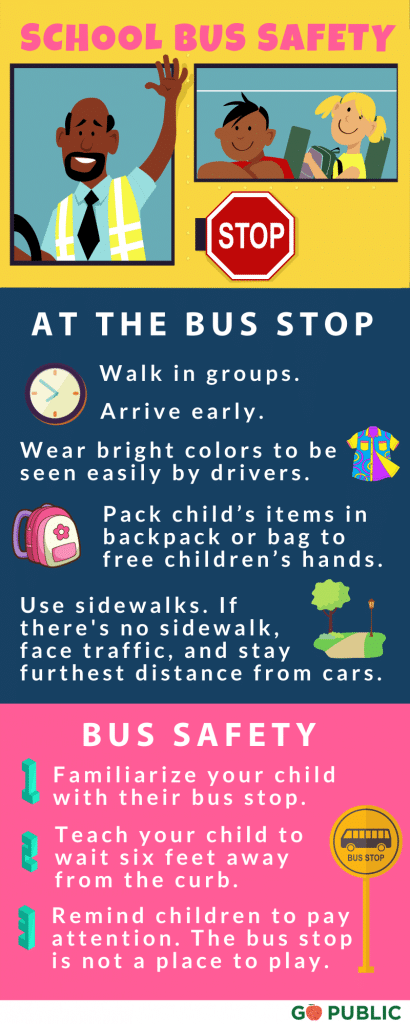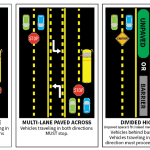STOP! FOR SCHOOL BUS SAFETY WEEK
We observe National School Bus Safety Week every October with the intention to address and promote school bus safety. As parents and drivers, we all share the responsibility of making sure schoolchildren are safe while traveling by bus. During this important week, the Texas Department of Public Safety (DPS) reminds and urges Texans to comply with school safety laws that prohibit drivers from passing school buses.
SCHOOL BUS SAFETY STANDARDS
Students in Texas rely on school bus services to get them to and from school every day. There are over 42,000 school busses serving more than 9,000 public schools in the state to provide safe school transportation services. The National Highway Traffic Safety Administration (NHTSA) states that students are around 70 times more likely to safely arrive at school by bus rather than traveling by other vehicles. This is because school buses are the most heavily regulated transportation vehicles. They are designed to be safe by being highly visible with vivid yellow paint, bright flashing red lights, and extended stop sign arms. School busses have protective seating to absorb impact in case of an accident. Additionally, they are extremely heavy machines with extra protection from rollovers. Laws are also in place to help protect students from other drivers. These laws make it illegal for drivers to pass school buses during pick up and drop off.
Why do some school busses have seatbelts and others do not?
National Highway Traffic Safety Administration states that the best crash protection for children in large school buses is by compartmentalization. This means that the interior of large buses protects children without the need for seat belts. Instead, the closely-spaced, strong, energy-absorbing seats are the best protection in case of an accident.
Smaller school buses are equipped with lap belts or shoulder belts at every seat. Because small school busses are closer to the size of passenger vehicles on the road, seat belts in those smaller busses are necessary to provide the most effective occupant protection.
KEEPING KIDS SAFE
Parents and communities can keep children safe in many ways. School bus stop rules are meant to ensure the safest practices for children and drivers. Starting with getting ready for school and until children arrive home, there are helpful daily techniques to practice. The NHTSA and National Association for Pupil Transportation offer these suggestions:
Getting to the Bus
– Encourage your child to wear brightly colored clothing to be easily seen by drivers.
– Pack your child’s belongings (including mobile devices) in a backpack or bag so that they don’t drop anything, and so their hands are free to use handrails on the bus.
– Arrive at the bus stop five minutes early by ensuring your child leaves home on time.
– Walk your child to the bus stop or encourage children to walk in groups.
– Always use the sidewalk. If there is no sidewalk, stay out of the street. If you must walk in the street, face traffic and stay close to the edge of the road.
At the Bus Stop
– Familiarize your child with their bus stop.
-Teach your child to wait six feet away from the curb.
-Remind children to pay attention, and reiterate that the bus stop is not a place to play.
– Teach your child how to safely get on and off the bus.
- Always wait until the bus comes to a complete stop.
- The driver will open the door and wave or signal that it is okay to approach the door.
- Point out the handrails to your child and encourage them to use the rails every time they enter or exit the bus.
– Demonstrate caution near the bus.
- Tell your child to never walk behind a bus.
- If they need to cross the street, do so at least 10 feet in front of the bus.
- Advise your child to make eye contact with the bus driver before crossing.
- When meeting your child after school at the bus stop, wait where the child will be dropped off. Do not wait across the street.
On the Road
– Watch for children:
- when backing out of driveways and garages.
- while driving in school zones.
- near bus stops.
– Be alert, slow down, obey the law
– Know the Flashing Signal Light System
- Flashing yellow lights mean the bus is slowing down and preparing to stop. Drivers should prepare to stop their vehicle.
- Extended stop arms and flashing red lights mean the bus has stopped. Drivers must stop and wait until the red lights stop flashing, the extended stop-sign arm is withdrawn, and the bus begins moving again. (Texas Department of Public Safety)
OTHER SAFETY MEASURES ON SCHOOL BUSSES
School Bus Cameras
Cameras installed on school busses are becoming more prevalent as they attempt to catch motorists who pass stopped school buses. The cameras are attached to the outside of the bus to record illegal passing. Violators can be fined up to $300 for an offense caught on a school bus camera. (School Bus Cameras Catch Reckless Drivers)
School Bus Safety and COVID
The Texas Education Agency (TEA) released a set of guidelines for schools to follow for extra protection during the COVID pandemic. TEA Public Health Guidance recommendations include that school districts should:
– Require students and staff to use hand sanitizer when entering the bus.
– Open bus windows to help air circulation.
– Sanitize busses after each trip.
– Encourage parents to drop off students, carpool, or walk to school to reduce possible exposure on busses.
Harlandale ISD custodians sanitize the bus after each trip
During National School Bus Safety week we remind ourselves of the rules of school bus safety. But a safe ride to and from school in a school bus also means fewer vehicles on the road, fewer emissions into the environment, peace of mind for families, and a place for kids to meet new friends. The next time you stop for one of those bright yellow wagons full of precious cargo, pat yourself on the back for knowing school bus safety rules!
ADDITIONAL RESOURCES:
Go Public Transportation Services
Go Public School Safety
Can you pass a school bus if the stop sign is not out?
Check out this informative video from KVUE
How to Report a Reckless Driver
Texas Department of Transportation Back to School Driving Tips
Bus Stop Near Me App Where’s The Bus


























